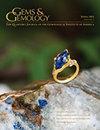Pearl Classification: The GIA 7 Pearl Value Factors
IF 1.6
3区 地球科学
Q2 MINERALOGY
引用次数: 4
Abstract
GEMS & GEMOLOGY SUMMER 2021 135 Prized by many cultures throughout history and frequently referred to as “The Queen of Gems,” pearls have long been one of the most sought-after gemstones in both the jewelry industry and the world at large. Their unique appearance and the affordability of cultured pearls in the market have allowed their popularity to grow exponentially over the years. Pearls form in a wide variety of sizes, shapes, and colors, and there are numerous different types of pearls, both natural and cultured. This diversity created the need for a way to distinguish their various appearances and qualities. Consequently, a number of different grading systems were developed within the pearl industry over the years. The competing, often company-specific methods and coded terminology made the systems difficult to understand and employ consistently. Agreeing on a universal approach to classify pearls has remained one of the main challenges facing the pearl industry. The idea of devising a pearl classification system similar to GIA’s 4Cs system for diamonds first appeared in Gems & Gemology in 1942 (Rietz, 1942a,b). The author suggested that pearls could be grouped into several categories such as gem quality, extra-fine quality, fine quality, good quality, fair quality, imperfect, and poor quality, based on several factors, namely shape, luster, surface blemishes, color distribution, and iridescence (commonly referred to as orient). This approach was further improved by GIA’s Richard T. Liddicoat Jr., who in 1967 proposed a new system based on the seven pearl value factors (Liddicoat, 1967). Continued refinement eventually resulted in the development of GIA’s current pearl classification system, called the GIA 7 Pearl Value Factors. This comprehensive pearl classification system offers a detailed description of the appearance of loose pearls, strands, and pearls in jewelry. It is a systematic approach to evaluation, through consistent methodology and common terminology that both industry professionals and consumers can understand (Zhou, 2019). This approach and the terminology of GIA’s updated system have already been adopted in many parts of the pearl industry for classifying and describing pearls. The wall chart presented here is based on a poster presentation from the 2018 GIA International Gemological Symposium (Ho and Shih, 2018). It provides the definitions and classification terminology for each of the seven value factors—size, shape, color, luster, surface, nacre, and matching—as well as digital images to illustrate various examples. Pearls fall into one of two varieties: nacreous (resembling mother-of-pearl with lustrous nacre) and non-nacreous (such as conch or melo pearls, lacking lustrous nacre but often displaying flame structure on the surface). This system applies to nacreous pearls (see figure 1) and exclusively for the three dominant types of saltwater cultured pearls: akoya, PEARL CLASSIFICATION: THE GIA 7 PEARL VALUE FACTORS珍珠分类:GIA 7珍珠价值因素
纵观历史,珍珠受到许多文化的珍视,经常被称为“宝石女王”,长期以来一直是珠宝行业和世界上最受欢迎的宝石之一。它们独特的外观和市场上养殖珍珠的可负担性使它们的受欢迎程度多年来呈指数级增长。珍珠的大小、形状和颜色各不相同,有许多不同类型的珍珠,既有天然的,也有养殖的。这种多样性需要一种方法来区分它们不同的外观和品质。因此,多年来,珍珠行业开发了许多不同的分级系统。相互竞争的,通常是公司特定的方法和编码术语使得系统难以理解和一致地使用。就统一的珍珠分类方法达成一致,一直是珍珠行业面临的主要挑战之一。设计一种类似于GIA钻石4c分类系统的珍珠分类系统的想法最早出现在1942年的《宝石与宝石学》(Rietz, 1942a,b)。作者建议根据珍珠的形状、光泽、表面瑕疵、颜色分布和虹彩(通常称为东方)等几个因素,将珍珠分为宝石级、特级、优质、优质、一般、不完美和劣质等几类。GIA的Richard T. Liddicoat Jr.进一步改进了这种方法,他在1967年提出了一个基于七个珍珠价值因素的新系统(Liddicoat, 1967)。持续的改进最终导致了GIA目前珍珠分类系统的发展,称为GIA 7珍珠价值因素。这个全面的珍珠分类系统提供了一个详细的描述外观松散的珍珠,股,珍珠首饰。这是一种系统的评估方法,通过一致的方法和行业专业人士和消费者都能理解的通用术语(Zhou, 2019)。这种方法和GIA更新系统的术语已经被珍珠行业的许多部门采用,用于珍珠分类和描述。这里展示的挂图是基于2018年GIA国际宝石学研讨会的海报展示(Ho and Shih, 2018)。它提供了七个值因素(大小、形状、颜色、光泽、表面、珍珠层和匹配)的定义和分类术语,并提供了数字图像来说明各种示例。珍珠分为两种:珍珠(类似珍珠母贝,有光泽的珍珠层)和非珍珠(如海螺或甜瓜珍珠,缺乏光泽的珍珠层,但表面经常显示火焰结构)。该系统适用于珍珠(见图1),仅适用于三种主要类型的海水养殖珍珠:akoya珍珠,珍珠分类:GIA 7珍珠价值因素
本文章由计算机程序翻译,如有差异,请以英文原文为准。
求助全文
约1分钟内获得全文
求助全文
来源期刊

Gems & Gemology
地学-矿物学
CiteScore
2.90
自引率
19.20%
发文量
10
期刊介绍:
G&G publishes original articles on gem materials and research in gemology and related fields. Manuscript topics include, but are not limited to:
Laboratory or field research;
Comprehensive reviews of important topics in the field;
Synthetics, imitations, and treatments;
Trade issues;
Recent discoveries or developments in gemology and related fields (e.g., new instruments or identification techniques, gem minerals for the collector, and lapidary techniques);
Descriptions of notable gem materials and localities;
Jewelry manufacturing arts, historical jewelry, and museum exhibits.
 求助内容:
求助内容: 应助结果提醒方式:
应助结果提醒方式:


